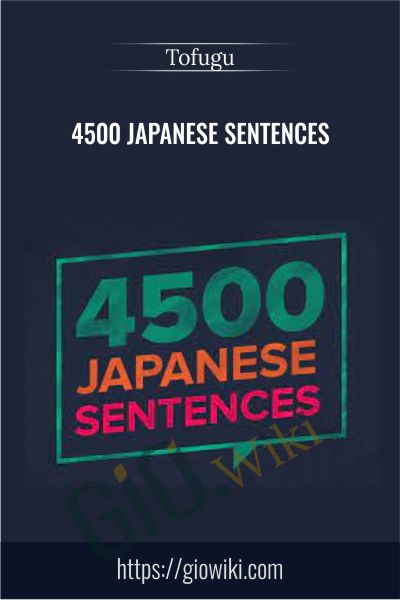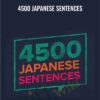$497.00 Original price was: $497.00.$34.00Current price is: $34.00.
This is what4,500 Japanese Sentencesis all about.Quantity, and lots of it. Your goal isn’t to perfectly translate these sentences. Far from it.Your goal is to get through them all as quick as you can.
 Purchase this course you will earn 34 Points worth of $3.40
Purchase this course you will earn 34 Points worth of $3.40Elevate your skills with the 4500 Japanese Sentences – Tofugu course, available for just $497.00 Original price was: $497.00.$34.00Current price is: $34.00. on Utralist.com! Browse our curated selection of over 60,000 downloadable digital courses across diverse Uncategorized. Benefit from expert-led, self-paced instruction and save over 80%. Start learning smarter today!
I’d like to start with a story from “Art & Fear”, a book written by David Bayles and Ted Orland.
The ceramics teacher announced on opening day that he was dividing the class into two groups. All those on the left side of the studio,he said, would be graded solely on the quantity of work they produced, all those on the right solely on its quality. His procedure wassimple: on the final day of class he would bring in his bathroom scales and weigh the work of the "quantity" group: fifty pound of potsrated an "A", forty pounds a "B", and so on. Those being graded on "quality", however, needed to produce only one pot albeit a perfectone to get an "A". Well, come grading time and a curious fact emerged: the works of highest quality were all produced by the groupbeing graded for quantity. It seems that while the "quantity" group was busily churning out piles of work and learning from their mistakes the "quality" group had sat theorizing about perfection, and in the end had little more to show for their efforts than grandiose theoriesand a pile of dead clay.
This is what4,500 Japanese Sentencesis all about.Quantity, and lots of it. Your goal isn’t to perfectly translate these sentences. Far from it.Your goal is to get through them all as quick as you can. If you get stuck, don’t spend a ton of time trying to figure it out. Move on to the nextsentence. You’re going to make mistakes and you’re going to be confused. That’s great! Move on to the next sentence already. Put a circle nextto it so you can come back to it. Whatever makes you happy, so long as you keep on moving.
Otherwise, the purpose of this workbook is quite simple. We’ve written for you a lot of sentences. Not only that, but we’ve based these sentencesoff of really useful and frequently used words. The higher you go the less frequently used these numbers will become, but they’re still quiteuseful. Here’s how you use the book.
- 1.Translate the word on the far left side into your language.
- 2.Translate the sentence in column three into your language.
Just do your best, remember: Quantity > Quality. If you go through 500 of these sentences you’ll notice a jump in your ability level. You’ll haveinput so much Japanese into your brain that some of it will stick. Not all of it, but enough to make a noticeable leap forward. If you do 500 moreyou’ll make another step forward. The second 500 will be easier than the first, too. if you finish all of these sentences, you’re going to makeconsiderable progress with your Japanese. But, you have a lot of sentences to get through, so you should get going.
As for level? Beginners probably shouldn’t try to do this. Let’s say “intermediate” and up. Otherwise, it’ll probably be too overwhelming. It shouldhurt a bit and be difficult, but you need a certain amount of foundation to get through it.
Get 4500 Japanese Sentences – Tofugu , Only Price $37
Tag: 4500 Japanese Sentences – Tofugu Review. 4500 Japanese Sentences – Tofugu download. 4500 Japanese Sentences – Tofugu discount.
Cultivate continuous growth with the 4500 Japanese Sentences – Tofugu course at Utralist.com! Unlock lifetime access to premium digital content, meticulously designed for both career advancement and personal enrichment.
- Lifetime Access: Enjoy limitless access to your purchased courses.
- Exceptional Value: Benefit from savings up to 80% on high-quality courses.
- Secure Transactions: Your payments are always safe and protected.
- Practical Application: Gain real-world skills applicable to your goals.
- Instant Accessibility: Begin your learning journey immediately after buying.
- Device Compatible: Access your courses seamlessly on any device.
Transform your potential with Utralist.com!
Related products
Uncategorized
Managing Patient Emergencies: Critical Care Skills Every Nurse Must Know – Dr. Paul Langlois
= 85 Points
Uncategorized
Cognitive Rehabilitation Therapy: Practical Interventions and Personalized Planning – Jane Yakel
= 85 Points
Uncategorized
Managing Geriatric Behaviors: Wandering, Aggression, Malnutrition and More – Steven Atkinson
= 35 Points
= 85 Points
Uncategorized
= 85 Points
= 72 Points
= 65 Points
= 84 Points





